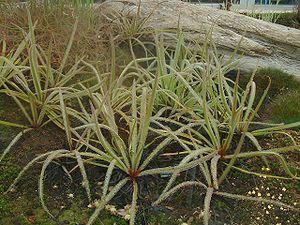King sundew
| King sundew | ||||||||||||
|---|---|---|---|---|---|---|---|---|---|---|---|---|

Drosera regia |
||||||||||||
| Systematics | ||||||||||||
|
||||||||||||
| Scientific name | ||||||||||||
| Drosera regia | ||||||||||||
| Stephens |
The king sundew ( Drosera regia ) is a carnivorous plant from the genus sundew ( Drosera ). The species, which is very rare in nature, occurs only in a small area in South Africa.
description
The king sundew is one of the largest species of the sundew genus. It is an upright-growing species with herbaceous growth and many strong adventitious roots that grow from a short rhizome .
The leaf buds are unusually curled outwards rather than inwards. The sessile, linear leaves are up to 40 centimeters long and 12 millimeters wide and taper to the thread-like tip of the leaf. They have a central rib that protrudes clearly downwards and are covered with long, knob-like tentacles to catch prey on their upper side and on the edge from the base of the leaves, the underside of the leaf itself is smooth.
Flowering time is January. The inflorescence is up to 40 cm high, cylindrical and hairless. The bracts are small and have a few reduced tentacles. The flower stalks are up to 15 millimeters long and also have reduced tentacles.
The flowers are large for the genus. The fused sepals are up to 13 millimeters long, densely covered with reduced tentacles, those of the edge are long-stalked. The white or old pink petals are obovate and around 2.5 inches long. The stamens are 15 mm long, the filaments cylindrical, the dust bag skewer-shaped at the base, tapering towards the top. The undivided stylus are 13 millimeters long, slender trumpet-shaped at the top, the scar covered with glandular hair. The oblong-round capsule is up to 8 millimeters long, the seeds are almost one millimeter long, the surface is networked and spindle-shaped.
distribution
The king sundew is a local endemic , it is only native to South Africa in a single valley on the Baineskloof Pass in the Western Cape Province , just under 120 kilometers north of Cape Town. There the species is found on sandy and peat soils in low grasslands.
The species is extremely rare in nature and threatened with extinction.
Systematics / evolution
The king sundew, along with its closest relative, the Australian Drosera arcturi , is the most basal sundew species.
It was first described by Edith Layard Stephens in 1926 . Its growth and pollen shape, which sets it apart from all other species of the genus, has led to its classification in its own subgenus Regiae . In 1996 Chrtek and Slavikova even classified it in its own genus as Freatulina regia , but this view is generally not followed.
proof
- ↑ a b c d e Anna Amelia Obermeyer: Droseraceae. In: The Flora of Southern Africa. Volume 13: Cruciferae, Capparaceae, Resedaceae, Moringaceae, Droseraceae, Roridulaceae, Podosfemaceae, Hydrostachyaceae. Botanical Research Institute - Department of Agricultural Technical Services - Republic of South Africa, Pretoria 1970, pp. 187-201.
- ^ A b c d Wilhelm Barthlott , Stefan Porembski, Rüdiger Seine, Inge Theisen: Carnivores. Biology and culture of carnivorous plants. Eugen Ulmer GmbH & Co., Stuttgart 2004, ISBN 3-8001-4144-2 , pp. 99 & 110.
- ↑ Fernando Rivadavia, Katsuhiko Kondo, Masahiro Kato, Mitsuyasu Hasebe: Phylogeny of the sundews, Drosera (Droseraceae), based on chloroplast rbcL and nuclear 18S ribosomal DNA sequences. In: American Journal of Botany. Vol. 90, No. 1, 2003, ISSN 0002-9122 , pp. 123-130, JSTOR 4122732 .
